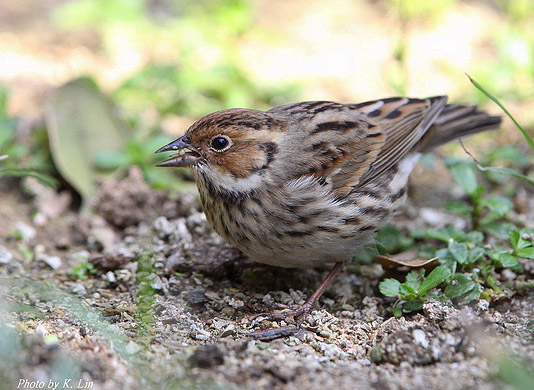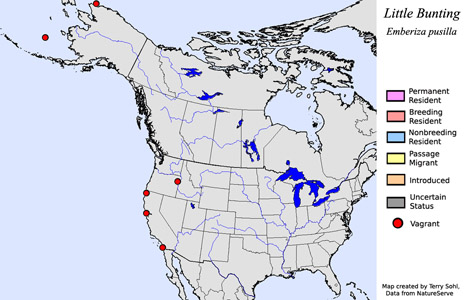| Length: 5 inches | Wingspan: 7.5 inches | Seasonality: Non-resident in South Dakota |
| ID Keys: Fine streaks on white underparts, heavy dark streaks on back, chestnut-colored face, white eye-ring | ||
 The
Little Bunting is a Eurasian species, where it breeds in parts of Russia and
Scandinavia, and winters in southern Asia. In North America it is a very
rare vagrant, most often seen in western Alaska, but it has strayed to
California and Oregon a handful of times. They are extremely hardy
little bird, found breeding in the far north tundra of Eurasia.
The
Little Bunting is a Eurasian species, where it breeds in parts of Russia and
Scandinavia, and winters in southern Asia. In North America it is a very
rare vagrant, most often seen in western Alaska, but it has strayed to
California and Oregon a handful of times. They are extremely hardy
little bird, found breeding in the far north tundra of Eurasia.
Habitat: Found in open taiga during the breeding season, in areas with dwarf willow and other open treed areas. Seems to prefer lower vegetation such as dwarf willow in much of its range, often in riparian areas. In migration and winter, they can be found in a wide variety of open habitats, including agricultural land, open forest land, and grassland.
Diet: Feeds heavily on seeds, but insects also make up a large part of the diet during the summer breeding season.
Behavior: Feeds while hopping on the ground.
Nesting: The nest is built on the ground on a mossy tussock, usually in a protected area such as next to a clump of vegetation or tree stump. The nest is a platform of moss, sticks, and grasses, lined with finer material such as fine grasses and lichen. The female lays between 4 and 6 eggs, and both parents help to incubate the eggs.
Song: The song is a short buzzy trilling.
Migration: Strongly migratory, summering in far northern Eurasia, and moving to China and other areas in southeastern Asia for the winter.
Interactive eBird map: Click here to access an interactive eBird map of Little Bunting sightings
Similar Species: Most likely to be confused with the Eurasian species Reed Bunting and Rustic Bunting.
Conservation Status: The Little Bunting is listed as a species of "Least Concern" by the IUCN. Populations are large, they appear to be stable, and they are found over a wide geographic area.
Further Information: 1) BirdLife International - Little Bunting
2) AviBirds - Little Bunting
3) Beauty of Birds - Little Bunting
Photo Information: Photo by K.Lin - Photo licensed under Creative Commons Attribution NonCommercial ShareAlike Generic 2.0 License.
| Click below for a higher-resolution map |
 |
| South Dakota Status: Non-resident in South Dakota |
Additional Little Bunting Photos (coming soon!!)
